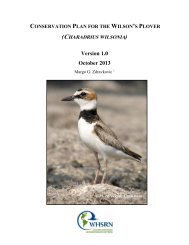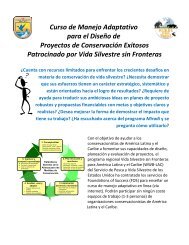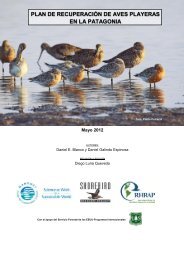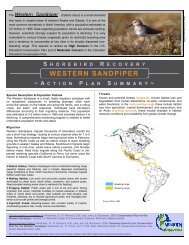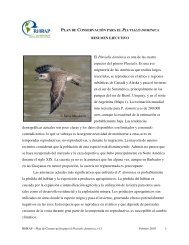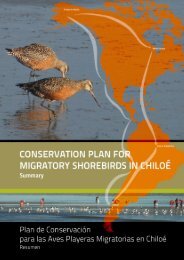Sanderling Plan - Western Hemisphere Shorebird Reserve Network
Sanderling Plan - Western Hemisphere Shorebird Reserve Network
Sanderling Plan - Western Hemisphere Shorebird Reserve Network
You also want an ePaper? Increase the reach of your titles
YUMPU automatically turns print PDFs into web optimized ePapers that Google loves.
incurring a massive oil spill (J. Buchanan, pers. comm.). This simple solution offers an important<br />
benefit to coastal wildlife, and might be a useful protective measure in other states with similar<br />
circumstances.<br />
At Delaware Bay, between 1982–2002 there were targeted efforts to raise awareness and<br />
reduce human disturbance (caused by wildlife photographers and bird watchers) of migrating<br />
shorebirds, including <strong>Sanderling</strong>s. This has resulted in the effective removal of the vast majority<br />
of disruptions by wildlife enthusiasts on the New Jersey side of Delaware Bay (Burger et al.<br />
2004).<br />
In Canada, the Great Lakes Water Quality Agreement of 1987 (between the United States<br />
and Canada) will benefit shorebirds indirectly through several associated initiatives aimed at<br />
improving habitat: the Binational Toxics Strategy (working to eliminate persistent toxic<br />
substances in the Great Lakes), and the Lake Ontario Lakewide Management <strong>Plan</strong> (working<br />
toward maintaining, restoring, and enhancing diverse biological communities for a number of<br />
shoreline areas (also see Ross et al. 2003).<br />
In Ontario, the framework of the Ontario Living Legacy Land Use Strategy (2000) for<br />
future land and resource management on Crown lands has identified the shorelines on Lake<br />
Superior and Lake Huron as a unique resource of global significance. Approximately 3,000<br />
kilometers of shoreline and adjacent lands have been designated Heritage Coastline (Ross et al.<br />
2003).<br />
At the multinational scale, proposed management by Wetlands for the Americas (now<br />
Wetlands International) includes protecting against loss of key habitat, and reducing chronic<br />
disturbance at sites traditionally used by ≥1,500 <strong>Sanderling</strong>s simultaneously. Additionally,<br />
management actions by the North American Waterfowl Management <strong>Plan</strong> (NAWMP) (est.<br />
1986), and land purchases through the North American Wetlands Conservation Act (NAWCA)<br />
also benefit shorebirds, including <strong>Sanderling</strong>s.<br />
SHIFTING CONSERVATION APPROACHES: A ‘COMMON GROUND’ PARADIGM<br />
Taking a problem-solving, common-ground approach is crucial to achieving the tricky<br />
balance between meeting wildlife (in this case, <strong>Sanderling</strong>) and human needs. Although this<br />
approach is becoming more common, it is not yet standard practice. Traditional approaches may<br />
inadvertently pit beach users against wildlife, resulting in conflict, resentment, and closed-<br />
WHSRN – <strong>Sanderling</strong> Conservation <strong>Plan</strong>, February 2010, v1.1 49





